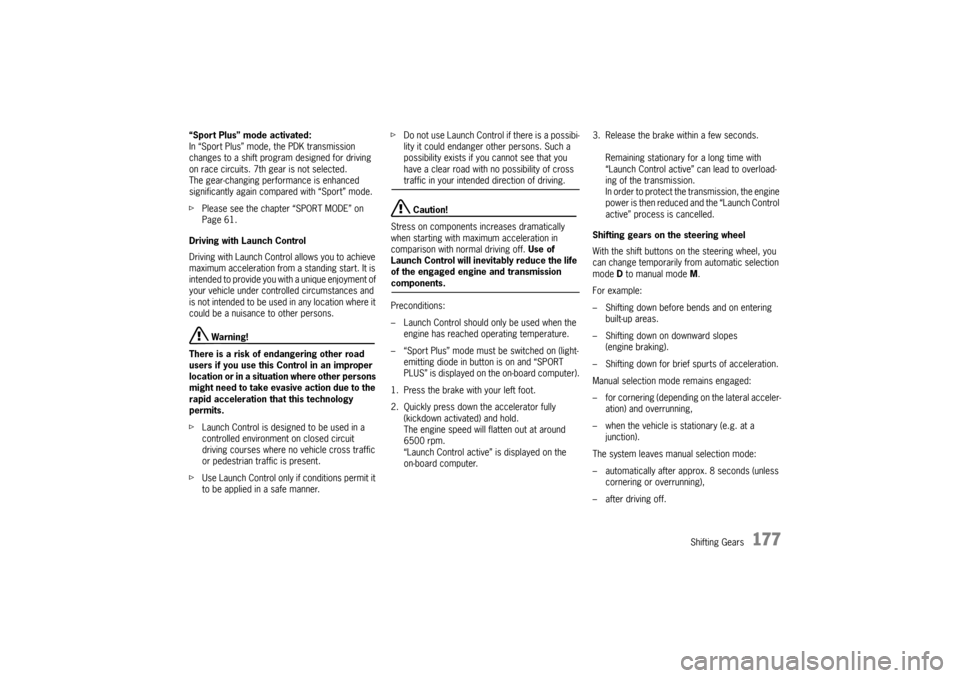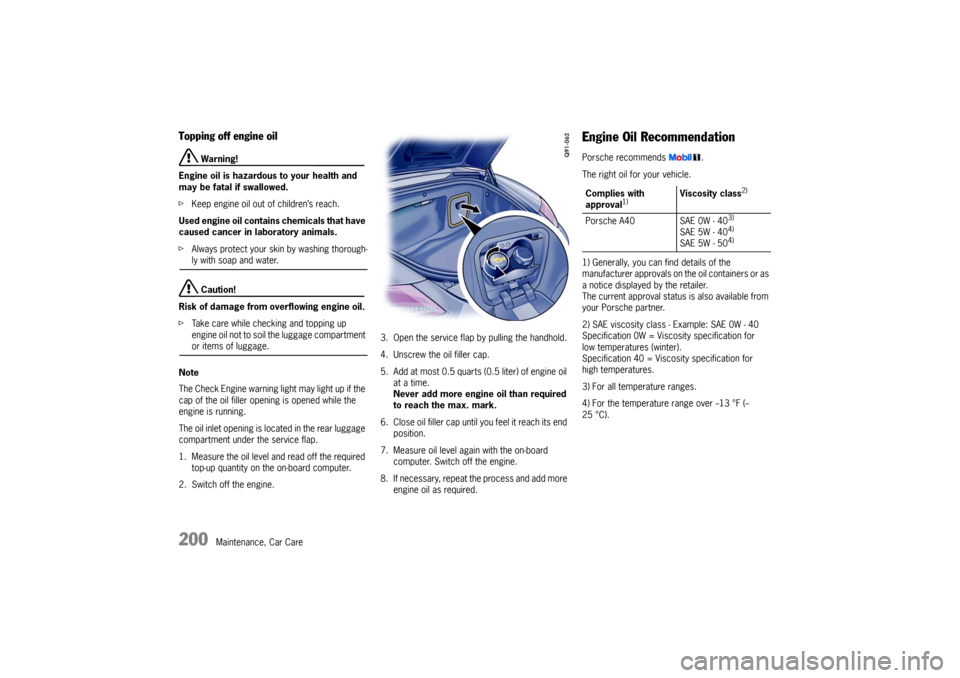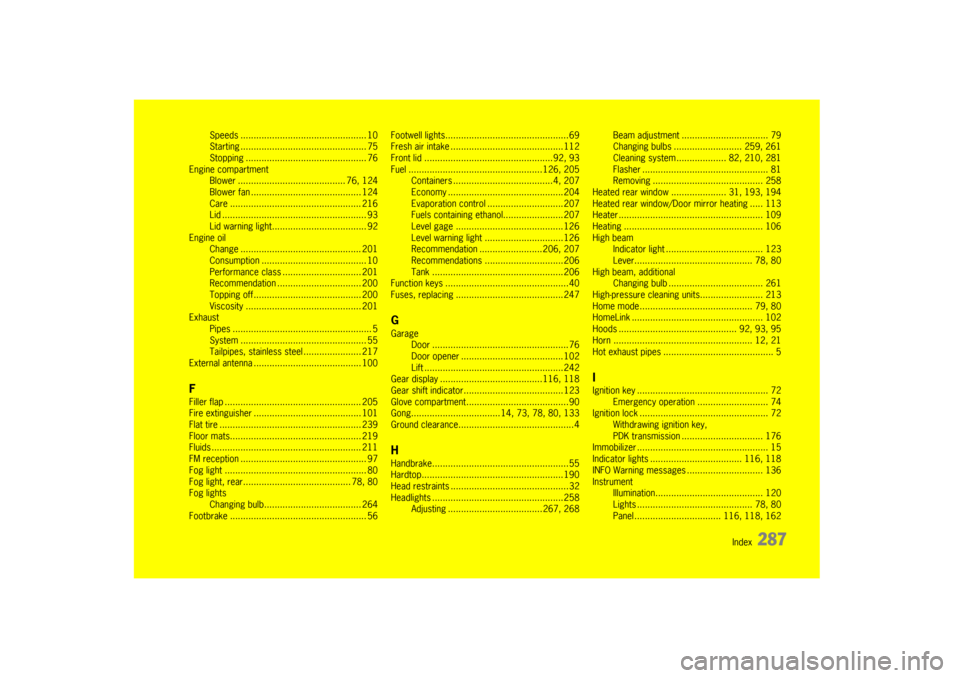2010 PORSCHE BOXSTER S display
[x] Cancel search: displayPage 179 of 294

Shifting Gears
177
“Sport Plus” mode activated:
In “Sport Plus” mode, the PDK transmission
changes to a shift program designed for driving
on race circuits. 7th gear is not selected.
The gear-changing performance is enhanced
significantly again compared with “Sport” mode.
fPlease see the chapter “SPORT MODE” on
Page 61.
Driving with Launch Control
Driving with Launch Control allows you to achieve
maximum acceleration from a standing start. It is
intended to provide you with a unique enjoyment of
your vehicle under controlled circumstances and
is not intended to be used in any location where it
could be a nuisance to other persons.
Warning!
There is a risk of endangering other road
users if you use this Control in an improper
location or in a situation where other persons
might need to take evas ive action due to the
rapid acceleration that this technology
permits.
f Launch Control is designed to be used in a
controlled environment on closed circuit
driving courses where no vehicle cross traffic
or pedestrian traffic is present.
f Use Launch Control only if conditions permit it
to be applied in a safe manner. f
Do not use Launch Control if there is a possibi-
lity it could endanger other persons. Such a
possibility exists if you cannot see that you
have a clear road with no possibility of cross
traffic in your intended direction of driving. Caution!
Stress on components increases dramatically
when starting with maximum acceleration in
comparison with normal driving off. Use of
Launch Control will inevitably reduce the life
of the engaged engine and transmission
components.
Preconditions:
– Launch Control should only be used when the engine has reached operating temperature.
– “Sport Plus” mode must be switched on (light- emitting diode in button is on and “SPORT
PLUS” is displayed on the on-board computer).
1. Press the brake with your left foot.
2. Quickly press down the accelerator fully (kickdown activated) and hold.
The engine speed will flatten out at around
6500 rpm.
“Launch Control active” is displayed on the
on-board computer. 3. Release the brake within a few seconds.
Remaining stationary for a long time with
“Launch Control active” can lead to overload-
ing of the transmission.
In order to protect the transmission, the engine
power is then reduced an d the “Launch Control
active” process is cancelled.
Shifting gears on the steering wheel
With the shift buttons on the steering wheel, you
can change temporarily fr om automatic selection
mode D to manual mode M.
For example:
– Shifting down before bends and on entering built-up areas.
– Shifting down on downward slopes (engine braking).
– Shifting down for brief spurts of acceleration.
Manual selection mode remains engaged:
– for cornering (depending on the lateral acceler- ation) and overrunning,
– when the vehicle is stationary (e.g. at a junction).
The system leaves manual selection mode:
– automatically after approx. 8 seconds (unless cornering or overrunning),
– after driving off.
Page 181 of 294

Shifting Gears
179
Depending on driving speed and engine speed,
you can shift up or down at any time.
Gear changes which would exceed the upper or
lower engine speed limit are not executed by the
controller.
There is no automatic upshift at the upper engine
speed limit in selector lever position M. Upshift
suppression can be cancelled by kickdown opera-
tion. If, for example, the engine speed limit is
reached during overtaking and the automatic
upshift does not occur, the transmission in this
case shifts up as a result of kickdown operation.
f Select an appropriately low gear on upward
and downward slopes.
This will ensure optimum use of engine power
and engine braking.
In order to shift up au tomatically at the upper
engine speed limit:
f Depress the accelerator pedal beyond the full-
throttle point (kickdown). Failure of the selector lever display on the
instrument cluster
The warning “Transmission emergency run” is
displayed in red on the on-board computer.
–Effect:
No selector lever position is displayed on the
instrument cluster.
Vehicle can be driven only until it comes to a
stop.
Remedy:
It is not possible to continue driving. Immedi-
ately stop the vehicle in a suitable place. Have
the vehicle towed to an authorized Porsche
dealer.
Please see the chapter “TOWING” on
Page 269.
Stoppingf For a brief stop (e.g. at a traffic light), leave the
selector lever in drive position and hold the
vehicle with the brake pedal.
f Do not hold the car on a slope using the
accelerator. Use the brake pedal or the
handbrake instead.
f Before leaving the vehicle, always apply the
handbrake and move the selector lever to
position P.Parkingf Go easy on the accelerator!
f When parking or manoeuvring in a small
space, control the speed by careful use of the
footbrake.Driving in winterIn wintry road conditions it is advisable to take
steep inclines in manual mo de. This prevents gear
changes occurring that could cause wheelspin.Tow-starting, towingf Please see the chapter “TOWING” on
Page 269.
Page 182 of 294

180
Shifting Gears
Reduced driving programIf there is a fault in the transmission
– Depending on priority, the warning “Transmis-sion emergency run” in white or red lettering or
the warning “Transmission temperature too
high” is displayed on the on-board computer.
Warning “Transmission emergency run” white
– Effects: Restricted gearshift comfort,
Reverse gear may not function.
Remedy:
Have the fault repaired immediately at an
authorized Porsche dealer. Warning “Transmission emergency run”
red
– Effect: Vehicle can be driven only until it comes to a
stop.
Remedy:
It is not possible to continue driving. Immedi-
ately stop the vehicle in a suitable place. Have
the vehicle towed to an authorized Porsche
dealer.
Warning “Transmission temperature too high”
–Effects: “Warning jerks” can be felt when driving off and
the engine power may be restricted.
Remedy:
Do not hold the vehicle with the accelerator on
a hill, for example. Hold the vehicle with the
brake. Reduce engine load. If possible, stop
the vehicle in a suitable place. Allow the engine
to run in selector lever position P or N until the
warning disappears.
Page 201 of 294

Maintenance, Car Care
199
Engine Oil It is important to perform oil changes regularly in
accordance with the intervals specified in the
“Maintenance” booklet.
Engine oil consumption
It is normal for your engine to consume oil.
The rate of oil consumption depends on the quality
and viscosity of oil, the speed at which the engine
is operated, the climate, road conditions as well
as the amount of dilution and oxidation of the
lubricant.
If the vehicle is used for repeated short trips, and
consumes a normal amount of oil, the engine oil
measurement may not show any drop in the oil
level at all, even after 600 miles (1,000 km) or
more. This is because the oil is gradually becom-
ing diluted with fuel or mo isture, making it appear
that the oil level has not changed.
The diluting ingredients evaporate out when the
vehicle is driven at high speeds, as on an express-
way, making it then appear that oil is excessively
consumed after driving at high speeds.
If the conditions you drive your vehicle in are
dusty, humid, or hot, the frequency of the oil
change intervals should be greater. If the vehicle is driven at a high rate of speed,
climatic conditions are warm, and the load is high,
the oil should be checked more frequently, as
driving conditions will determine the rate of oil
consumption.
– The engine in your vehicle depends on oil to
lubricate and cool all of its moving parts.
Therefore, the engine oil should be checked
regularly and kept at the required level.
– Make it a habit to have the engine oil level checked at every fuel filling.
– The oil pressure warning light is not an oil level indicator.
The oil pressure warning light indicates serious
engine damage may be occuring when lit, if en-
gine rpm is above idle speed.
Engine Oil Level f Please see the chapter “EXERCISE EXTREME
CAUTION WHEN WORKING ON YOUR VEHICLE”
on Page 196.
f Regularly check the oil level using the on-board
computer after the vehicle is refuelled.
Please see the chapter “OIL DISPLAY AND
MEASUREMENT OF THE ENGINE OIL LEVEL”
on Page 157.
The difference between the minimum and maxi-
mum marks on the segment display is approx.
1.3 quarts (1.25 liters).
Each segment of the display corresponds to ap-
prox. 0.42 quart (0.4 liter).
Page 202 of 294

200
Maintenance, Car Care
Topping off engine oil
Warning!
Engine oil is hazardous to your health and
may be fatal if swallowed.
f Keep engine oil out of children’s reach.
Used engine oil contains chemicals that have
caused cancer in laboratory animals.
f Always protect your skin by washing thorough-ly with soap and water. Caution!
Risk of damage from overflowing engine oil.
f Take care while checking and topping up
engine oil not to soil the luggage compartment or items of luggage.
Note
The Check Engine warning light may light up if the
cap of the oil filler open ing is opened while the
engine is running.
The oil inlet opening is lo cated in the rear luggage
compartment under the service flap.
1. Measure the oil level and read off the required top-up quantity on the on-board computer.
2. Switch off the engine. 3. Open the service flap by pulling the handhold.
4. Unscrew the oil filler cap.
5. Add at most 0.5 quar ts (0.5 liter) of engine oil
at a time.
Never add more engine oil than required
to reach the max. mark.
6. Close oil filler cap until you feel it reach its end
position.
7. Measure oil level again with the on-board computer. Switch off the engine.
8. If necessary, repeat the process and add more engine oil as required.
Engine Oil RecommendationPorsche recommends .
The right oil for your vehicle.
1) Generally, you can find details of the
manufacturer approvals on the oil containers or as
a notice displayed by the retailer.
The current approval status is also available from
your Porsche partner.
2) SAE viscosity class - Example: SAE 0W - 40
Specification 0W = Viscosity specification for
low temperatures (winter).
Specification 40 = Viscosity specification for
high temperatures.
3) For all temperature ranges.
4) For the temperature range over --13 °F (--
25 °C).Complies with
approval
1)
Viscosity class
2)
Porsche A40 SAE 0W - 40
3)
SAE 5W - 40
4)
SAE 5W - 50
4)
Page 209 of 294

Maintenance, Car Care
207
Unleaded fuels may not be available outside the
continental U.S. and Canada. Therefore, we rec-
ommend you do not take your car to areas or
countries where unleaded fuel may not be availa-
ble. Octane ratings Octane rating indicates a fuel’s ability to resist det-
onation. Therefore, buying the correct octane gas
is important to prevent engine “damage”.
The RON octane rating is based on the research
method. The CLC (U.S. Cost of Living Council oc-
tane rating) or AKI ( anti knock index) octane rating
usually displayed on U.S. fuel pumps is calculated
as research octane numb er plus motor octane
number, divided by 2, that is written as:
The CLC or AKI octane rating is usually lower than
the RON rating:
For example: 95 RON equals 90 CLC or AKI
Fuels containing ethanolDo not use any fuels containing more than 10 per-
cent ethanol by volume.
We recommend, however, to change to a different
fuel or station if any of the following problems oc-
cur with your vehicle:
– Deterioration of driveability and performance.
– Substantially reduced fuel economy.
– Vapor lock and non-start problems, especially at high altitude or at high temperature.
– Engine malfunction or stalling. Portable Fuel Containers
Danger!
Portable fuel containers, full or partially
empty, may leak causing an explosion, or re-
sult in fire in case of an accident.
f Never carry additional fuel in portable contain-ers in your vehicle.
Fuel Evaporation Control Fuel tank venting The evaporation chamber and the carbon canister
prevent fuel from escaping to the atmosphere at
extreme high outside temperatures, when driving
abruptly around curves and when the car is parked
at an incline or in any other nonlevel position. Vapor control system and storage When the fuel tank is filled, vapors are collected in
the evaporation chamber by a vent line leading the
vapors to the carbon canister where they are
stored as long as the engine does not run. Purge system When the engine is running, the fuel vapors from
the canister will be mixed with fresh air from the
ambient air of the canister. This mixture will be
directed to the intake air housing by the tank vent
line, mixed with the intake air and burned during
normal combustion.
RON+MON
2
R+M
2
or
Page 289 of 294

Index
287
Speeds ................................................ 10
Starting .................. .............................. 75
Stopping .............................................. 76
Engine compartment Blower ....................... .................. 76, 124
Blower fan .............. ............................ 124
Care .................................................. 216
Lid ....................................................... 93
Lid warning light...... .............................. 92
Engine oil Change .............................................. 201
Consumption ............................... ......... 10
Performance class .. ............................ 201
Recommendation ........ ........................ 200
Topping off............. ............................ 200
Viscosity ................ ............................ 201
Exhaust
Pipes ......................... ............................ 5
System ................................................ 55
Tailpipes, stainless st eel ...................... 217
External antenna ......... ................................ 100
FFiller flap .................................................... 205
Fire extinguisher ......................................... 101
Flat tire ...................... ................................ 239
Floor mats.................. ................................ 219
Fluids ......................................................... 211
FM reception ................................... ............. 97
Fog light ............................................. ......... 80
Fog light, rear................. ........................ 78, 80
Fog lights Changing bulb......... ............................ 264
Footbrake ........................................... ......... 56Footwell lights...........
....................................69
Fresh air intake ......... ..................................112
Front lid ....................... ..........................92, 93
Fuel ..................... ..............................126, 205
Containers ................ ......................4, 207
Economy .................. ..........................204
Evaporation control .............................207
Fuels containing etha nol.......................207
Level gage ............... ..........................126
Level warning light ..............................126
Recommendation ........................206, 207
Recommendations .... ..........................206
Tank ..................................................206
Function keys ........... ....................................40
Fuses, replacing ....... ..................................247
GGarage
Door ....................................................76
Door opener .......................................102
Lift ............... ......................... .............242
Gear display ................. ......................116, 118
Gear shift indicator ......................................123
Glove compartment... ....................................90
Gong.................... ..............14, 73, 78, 80, 133
Ground clearance...... ......................................4HHandbrake.................... ................................55
Hardtop........................ ..............................190
Head restraints ......... ....................................32
Headlights .................... ..............................258
Adjusting .................. ..................267, 268 Beam adjustment .
................................ 79
Changing bulbs .......................... 259, 261
Cleaning system ....... ............ 82, 210, 281
Flasher ................................................ 81
Removing ................ .......................... 258
Heated rear window ..... ................ 31, 193, 194
Heated rear window/Door mirror heating ..... 113
Heater ......................... .............................. 109
Heating ........................................... .......... 106
High beam Indicator light ....... .............................. 123
Lever....................... ...................... 78, 80
High beam, additional Changing bulb ...... .............................. 261
High-pressure cleaning units........................ 213
Home mode..................... ...................... 79, 80
HomeLink .................... .............................. 102
Hoods ............................. ................ 92, 93, 95
Horn ........................................... .......... 12, 21
Hot exhaust pipes ... ....................................... 5
IIgnition key ............. ..................................... 72
Emergency operation ........................... 74
Ignition lock ............ ..................................... 72
Withdrawing ignition key,
PDK transmission ..................... .......... 176
Immobilizer ...................................... ............ 15
Indicator lights ................. .................. 116, 118
INFO Warning message s ............................. 136
Instrument Illumination........... .............................. 120
Lights ...................... ...................... 78, 80
Panel ........................... ...... 116, 118, 162
Page 290 of 294

288
Index
Interior
....................... .................................. 69
Interior lights ......... ....................................... 69
Interior mirror ............. .................................. 30
JJumper cables ............................................ 255KKey codes ...................... .............................. 15
Keys ................. ......................... ............ 15, 16LLATCH System ............... .............................. 54
Launch Control ........................................... 177
Leather care .............. ................................ 218
License plate light................................... 78, 80
Lids ........................................... ............ 93, 95
Emergency unlocking .......................... 248
Lifting vehicle ............. ................................ 242
Light
Daytime driving ....... .............................. 78
Flasher....................... ...... 78, 80, 81, 123
Low beam .................. .............. 78, 80, 81
Sensor for instrument illumination 116, 118
Switch........................ .............. 78, 80, 81
Light alloy wheels
Inscription .............. ............................ 233
Light functions, indivi dual............................... 81
Lights ................................................. ......... 69
Care .................................................. 218
Headlight beam adju stment ................... 79
LIMIT Acoustic warning signal for speed limit 133
Load switch-off ........... ................................ 246 Loading information ..
.................................. 234
Locking ........................ .......................... 20, 23
Low beam .................... ................................ 81
Luggage Net .......................... ............................ 91
Luggage compartment . ................................. 94
Lid ........................... ............................ 92
Lid warning light.... ................................ 92
Unlocking lid ......... ................................ 16
Luggage compartment/
engine compartment lid, warning lights ........... 92
MMaintenance ................. .............................. 196
Make-up mirror ............. ................................ 41
Maximum permitted engi ne speeds ................ 10
Manual transmission ............................ 172
Mirror Folding in.............. ................................ 30
Heating .................... .................... 31, 113
Inside ................................................... 29
Mirrors ............................. ...................... 29, 71
Anti-glare ................................... ........... 30
Multi-functional steeri ng wheel ........................ 40NNavigation .................... ................................ 97
Selection field, on-board computer ....... 146
Notes on
Car care ................... .......................... 213
Maintenance ............. .......................... 196
Number plate light ........ .......................... 78, 80
Changing bulb ....... .............................. 266
OOctane rating ...................................... 206, 207
Odometer ........................ ...........................121
Off delay .................... ............................79, 80
Oil...................... ............................. ...199, 281
Change........................ .......................201
Checking level.......... ...........................157
Consumption............ .............................10
Level checks............ ...........................199
Level indicator ......... ...........................157
Recommendation ......... .......................200
Topping off engine oi l ..........................200
OIL Display and measurement
of the engine oil leve l...................................157
On-board computer ..... ................................130
Basic settings .......... ...................131, 159
Calling on-board computer functions .....131
Functions and display possibilities ........131
General information . ............................160
Language versions ... ...........................159
Operation, controls... ...........................130
Selecting a radio station ......................146
Setting the clock ...... ...........................160
Switching daytime driving lights on/off ..160
Switching on navigation .......................146
Tire pressure warnings ........................152
Warnings and messag es ......................162
On-board literature ..........................................2
Operating voice contro l ...............................130
Operating your Porsche in other Countries ....204
Orientation light ...... ......................................69
Outside temperatur indicator........................127
Oxygen sensor............ ................................209